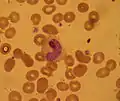Band cell
A band cell (also called band neutrophil, band form or stab cell) is a cell undergoing granulopoiesis, derived from a metamyelocyte, and leading to a mature granulocyte.
| Band cell | |
|---|---|
| Details | |
| Precursor | metamyelocyte |
| Gives rise to | Granulocyte |
| Identifiers | |
| TH | H2.00.04.3.04011 |
| Anatomical terms of microanatomy | |



It is characterized by having a curved but not lobular nucleus.[1]
The term "band cell" implies a granulocytic lineage (e.g., neutrophils).[2]
Clinical significance
Band neutrophils are an intermediary step prior to the complete maturation of segmented neutrophils. An increase in band neutrophils typically means that the bone marrow has been signaled to release more WBCs and increase production of WBCs, also known as a "left shift". Most often this is due to infection or inflammation in the body.
Blood reference ranges for neutrophilic band cells in adults are 3 to 5% of white blood cells,[3] or up to 0.7 x109/L.[4]
An excess may sometimes be referred to as bandemia.
See also
Additional images
 Band neutrophil in peripheral blood film
Band neutrophil in peripheral blood film_diagram_en.svg.png.webp) Hematopoiesis
Hematopoiesis
References
- "band cell" at Dorland's Medical Dictionary
- "Eosinophilic band". Archived from the original on 2008-08-29. Retrieved 2009-03-01.
- Last page of Deepak A. Rao; Le, Tao; Bhushan, Vikas (2007). First Aid for the USMLE Step 1 2008 (First Aid for the Usmle Step 1). McGraw-Hill Medical. ISBN 978-0-07-149868-5.
- Clinical Laboratory Medicine. By Kenneth D. McClatchey. Page 807.
External links
- Histology image: 01807loa – Histology Learning System at Boston University - "Bone Marrow and Hemopoiesis: bone marrow smear, neutrophil series"
- Histology at KUMC blood-blood11
- Histology image: 75_07 at the University of Oklahoma Health Sciences Center
- Histology at okstate.edu
- Slide at hematologyatlas.com - "Neutrophil band" visible in second row
- Interactive diagram at lycos.es